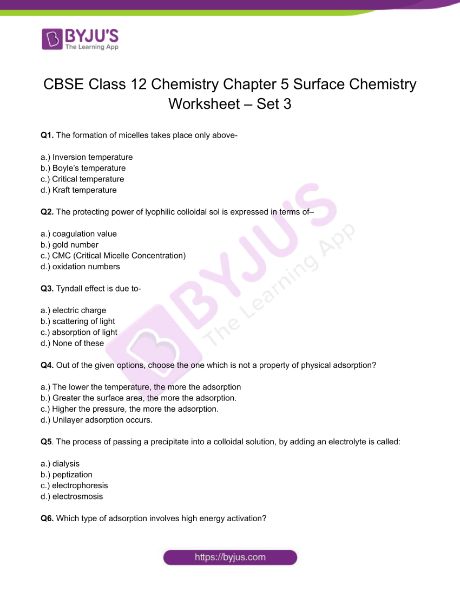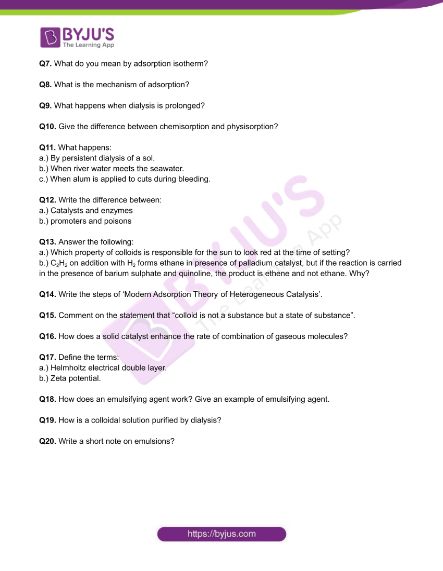Surface chemistry is the study of the physical and chemical phenomena that occur at the boundary (interface) between two bulk phases.
A pure compound or a solution can be used as the bulk phase.
The bulk phases can be solid-liquid, solid-gas, solid-vacuum, liquid-gas, and so on.
Some applications of surface chemistry are known as surface engineering. There are various phenomena taking place on the surface of substances and some of them are:
- Adsorption
- Heterogeneous Catalysis
- Corrosion
- Crystallization
Download Class 12 Chemistry Worksheet on Chapter 5 Surface Chemistry Set 3 PDF
CBSE Class 12 Chemistry Chapter 5 Surface Chemistry Worksheet – Set 3
Q1. The formation of micelles takes place only above-
a.) Inversion temperature
b.) Boyle’s temperature
c.) Critical temperature
d.) Kraft temperature
Q2. The protecting power of lyophilic colloidal sol is expressed in terms of–
a.) coagulation value
b.) gold number
c.) CMC (Critical Micelle Concentration)
d.) oxidation numbers
Q3. Tyndall effect is due to-
a.) electric charge
b.) scattering of light
c.) absorption of light
d.) None of these
Q4. Out of the given options, choose the one which is not a property of physical adsorption?
a.) The lower the temperature, the more the adsorption
b.) Greater the surface area, the more the adsorption.
c.) Higher the pressure, the more the adsorption.
d.) Unilayer adsorption occurs.
Q5. The process of passing a precipitate into a colloidal solution, by adding an electrolyte is called:
a.) dialysis
b.) peptization
c.) electrophoresis
d.) electrosmosis
Q6. Which type of adsorption involves high energy activation?
Q7. What do you mean by adsorption isotherm?
Q8. What is the mechanism of adsorption?
Q9. What happens when dialysis is prolonged?
Q10. Give the difference between chemisorption and physisorption?
Q11. What happens:
a.) By persistent dialysis of a sol.
b.) When river water meets the seawater.
c.) When alum is applied to cuts during bleeding.
Q12. Write the difference between:
a.) Catalysts and enzymes
b.) promoters and poisons
Q13. Answer the following:
a.) Which property of colloids is responsible for the sun to look red at the time of setting?
b.) C2H2 on addition with H2 forms ethane in presence of palladium catalyst, but if the reaction is carried in the presence of barium sulphate and quinoline, the product is ethene and not ethane. Why?
Q14. Write the steps of ‘Modern Adsorption Theory of Heterogeneous Catalysis’.
Q15. Comment on the statement that “colloid is not a substance but a state of substance”.
Q16. How does a solid catalyst enhance the rate of combination of gaseous molecules?
Q17. Define the terms:
a.) Helmholtz electrical double layer.
b.) Zeta potential.
Q18. How does an emulsifying agent work? Give an example of an emulsifying agent.
Q19. How is a colloidal solution purified by dialysis?
Q20. Write a short note on emulsions?
Download the PDF to access answers to the Chemistry Worksheet for Class 12 Chemistry Chapter 5 Surface Chemistry Set -3.
Download PDF


Comments